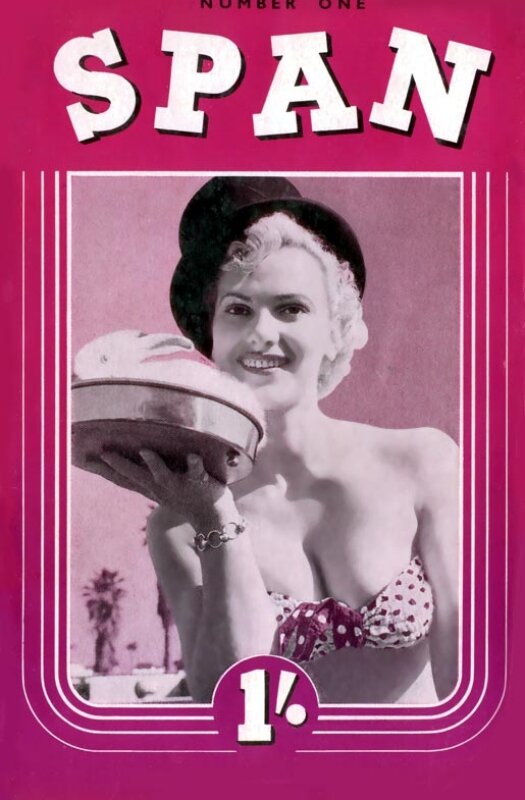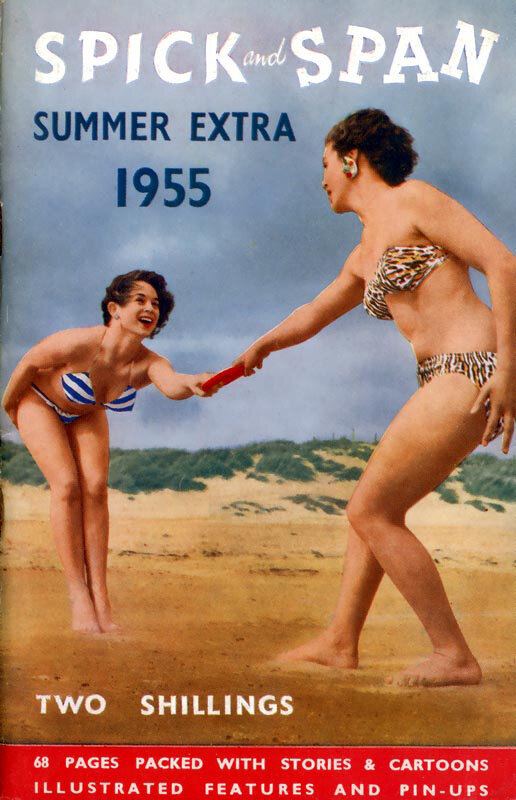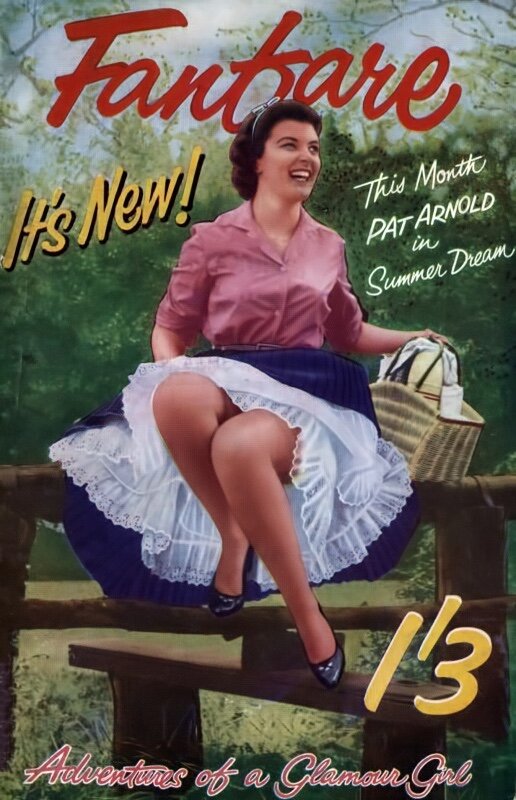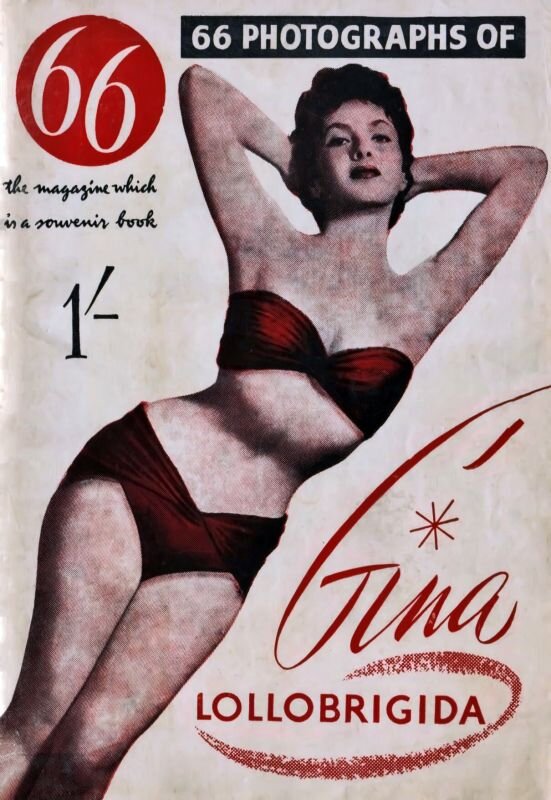Town and Country Publications (ToCo) – 1953-1976
Spick, Span and Beautiful Britons were the longest-running and most successful of the pin-up magazines to emerge in post-war Britain. They were published by Town and Country Publications (known later as ToCo) during the 1950s, ‘60s and ‘70s. Although the early editions featured a well-known glamour figure from stage or screen (such as Diana Dors, Sabrina, Joan Collins and Anita Ekberg to mention just a few), they were soon replaced by the icon for which they became famous − the typical “girl next door” that all males could identify with.
But Spick and Span also launched many a career for ‘unknown faces’ who went on to carve out successful film and stage careers – Shirley Eaton, for example, who won international fame as the girl James Bond found dead after being covered from head to foot in gold paint in Goldfinger.
Long before they became collectors’ items, the mags became hugely popular for their pictures of pretty girls-next-door posing in 1950s-style underwear, particularly stockings, in blatantly suburban settings – G-Plan sideboards, chinzy sofas and heavily patterned wallpaper became as much of a ToCo trademark as the naughty-but-nice girls themselves. The accidental-on-purpose flash of suspender and stocking top became synonymous with the ToCo titles and the main attraction to the people (mostly men – but far from exclusively so in the early days) who bought them. But one poor soul in Canada was moved to write a letter, published in Span 57 (May 1969), asking “why do most of your models in Britain show the tops of their stockings?” The mind boggles. The only sensible answer that springs to mind is “you’ll understand when you’re a bit older”.
The magazines had instant appeal and readership ran into several thousands, with distribution even extending to Albania (according to BB184), spurring the publishers to cash in by introducing new titles quickly. But with the advent of more explicit magazines in the early 1970s, their faithful audiences were insufficient to support them. In response to a reader’s letter in the February 1964 edition of Spick, when ToCo was approaching the peak of its success, editor R.T. Staples wrote prophetically, “perhaps our long experience is gradually leading us towards the summit, where we will no doubt fall over the edge”. That didn’t happen for another 13 years − the company went out of business at the end of 1976.
Today, they are collected for their relative innocence, and older collectors enjoy the sense of nostalgia that takes them back to the time when women truly were women – and they were just boys or young men. They show how times have changed − pre-decimal currency, pre-EU, pre-Women’s Lib (“Most men don’t like girls to go in for anything that will distract them from eventually becoming beautiful and domesticated” − photo cap from Spick 172, March 1968). They also present a pictorial history of what was going on in the world (there is a pixcap in Span Extra 4 that says Diane Clare will “stop you having nightmares about Sputnik”, the first man-made object put into space by the Russians in 1957), ladies’ fashion and glamour from the 1950s to the 1970s.
Fully fashioned stockings (that is stockings made with the shape of a leg rather than a tube of nylon) were the only ones available until 1952, the year after the stiletto heel appeared on the market. But it took several years for non-seamed stockings (RHT – Reinforced Heel and Toe) to replace them. Indeed, in the armed forces, or at least the Royal Navy, fully fashioned stockings were regulation throughout the sixties and still available at Naval stores (and worn by some Wren officers, much to the delight of callow lieutenants and lecherous admirals alike) well into the seventies. This trend is evident in the course of these magazines. Indeed, in Spick 114 from May 1963, a reader is moved to write a letter requesting “more seam, There are far too many seamless nylons about”. ToCo always claimed to follow the fashion of the day and editor Staples replied, “If the fashion is seamless nylons, then that’s what the girls will wear, and there’s very little we can do about it until Dior decides to put the seams back again”. But the popularity of genuine seamed stockings is so great that they are still in huge demand today. There are many cheap, seamed brands available – but the flat knit, fully-fashioned variety are not so easy to find and command much higher prices. Though true nylon fetishists will snap them up however expensive they are.
Throughout their 23 years of publication, more than 4,500 different models were featured in 1,033 magazines. All the ToCo titles were pocket-size books of approximately A5 format, with the exception of three larger-format issues of Spick (195-197) and Span (185-187) in the spring of 1970. This step was taken to compete with the plethora of other mags on sale but proved to be extremely unpopular with readers and was quickly dropped.
The magazines were published monthly, but numerous quarterly Extras, Annuals andHoliday Specials also appeared throughout the years.The number of pages varied from 44-52 pages in the monthly editions, 80 or so in the Extras and 100-plus in the Annuals and Holiday Specials. The photos were almost exclusively black and white throughout.
Few histories are the result of the work of one individual alone. My files are the result of analysis of my own collection, from numerous other sources and websites and from reading the work and thoughts of others. Much of the information available is anonymous or repetition, not credited with a source and therefore difficult to acknowledge. What we are doing here is to combine all that information and speculation to give a clearer picture of the history and development of ToCo Publications and its magazines. My personal contribution centres much more on the magazines themselves and the models they contain. It must also be understood that putting together the jigsaw puzzle of these magazines from half a century ago relies on snippets of information that are not necessarily reliable. The job is far from complete, so we make no claims of absolute accuracy and welcome any information that can fill in blanks or correct errors.





